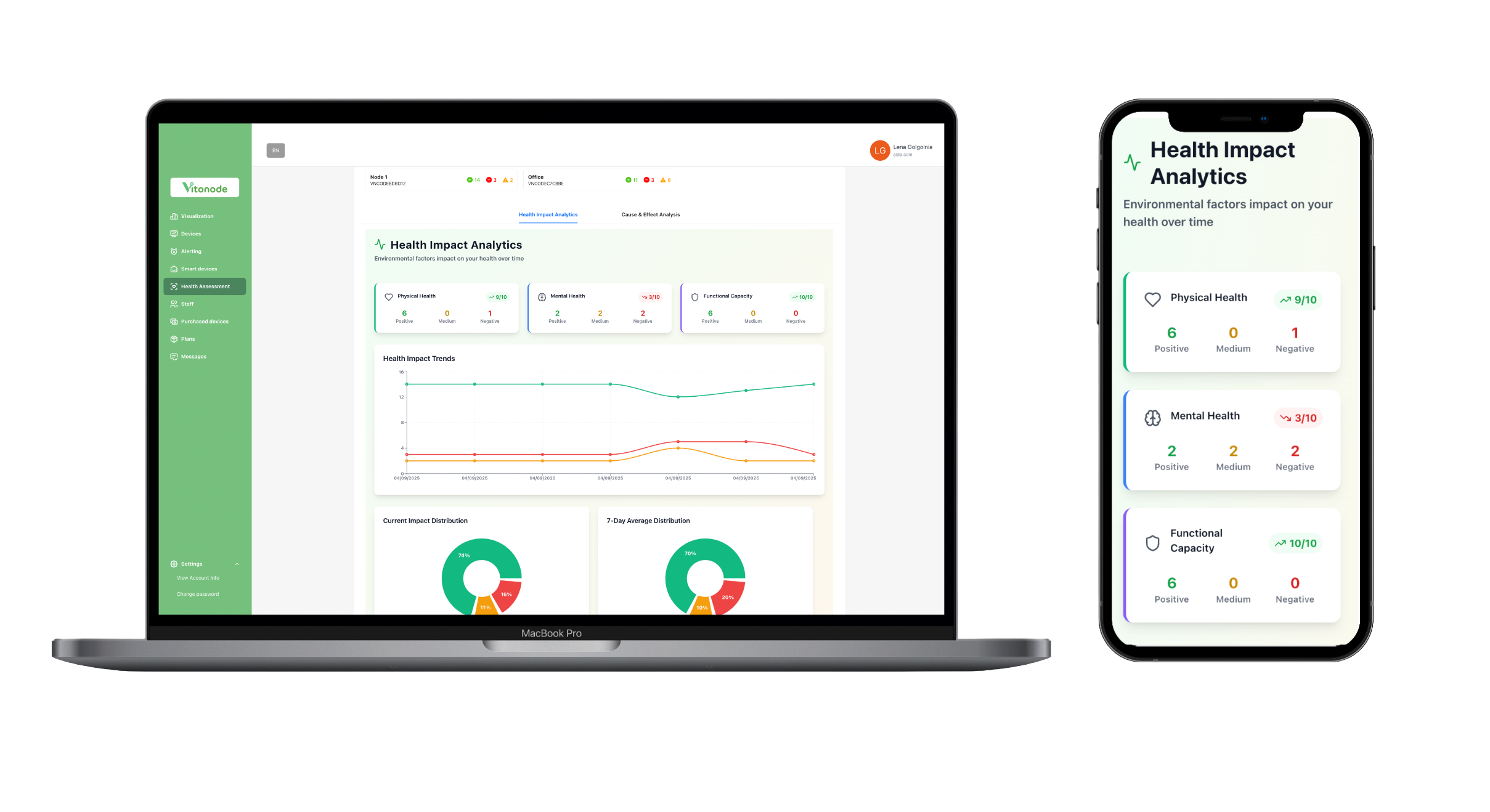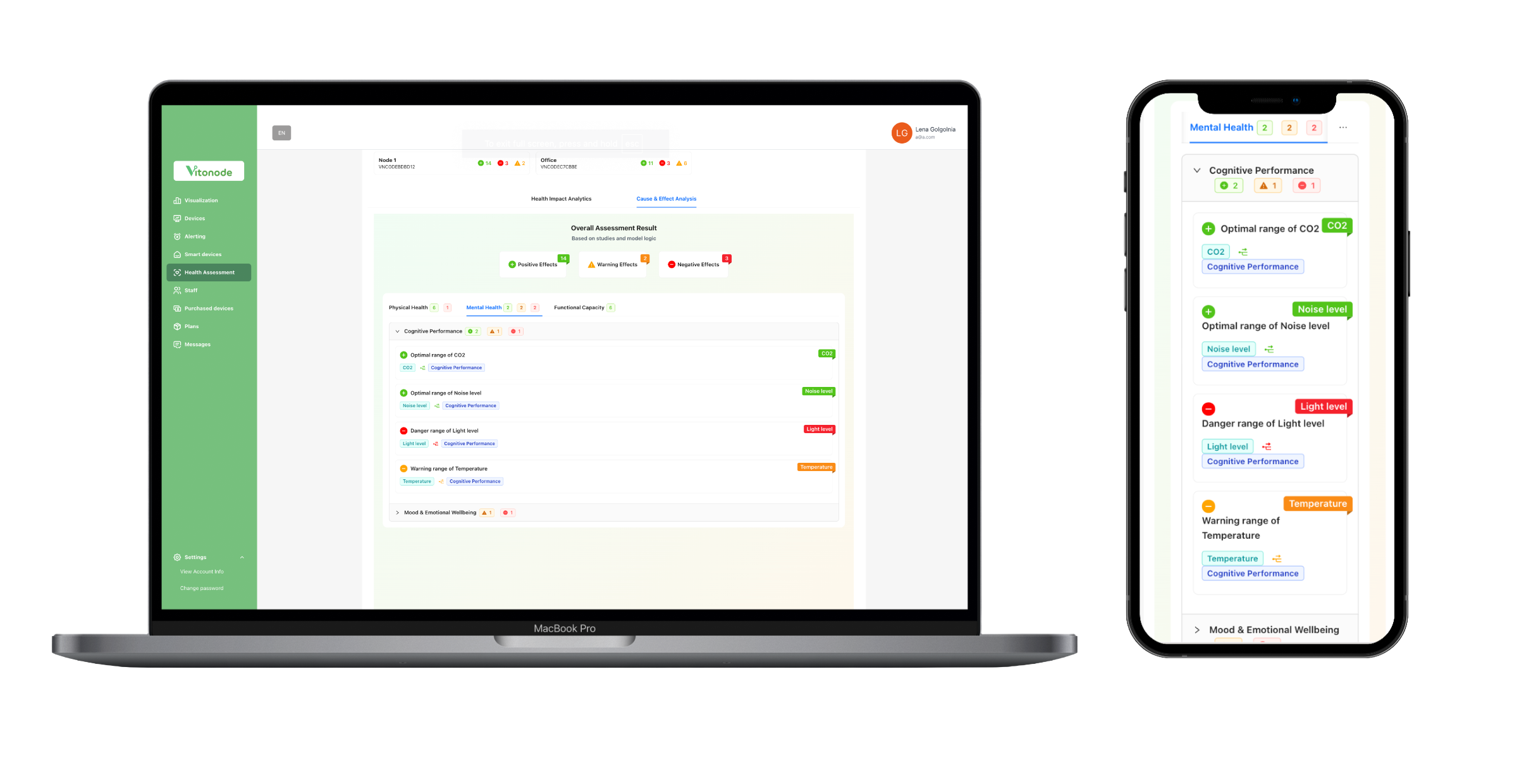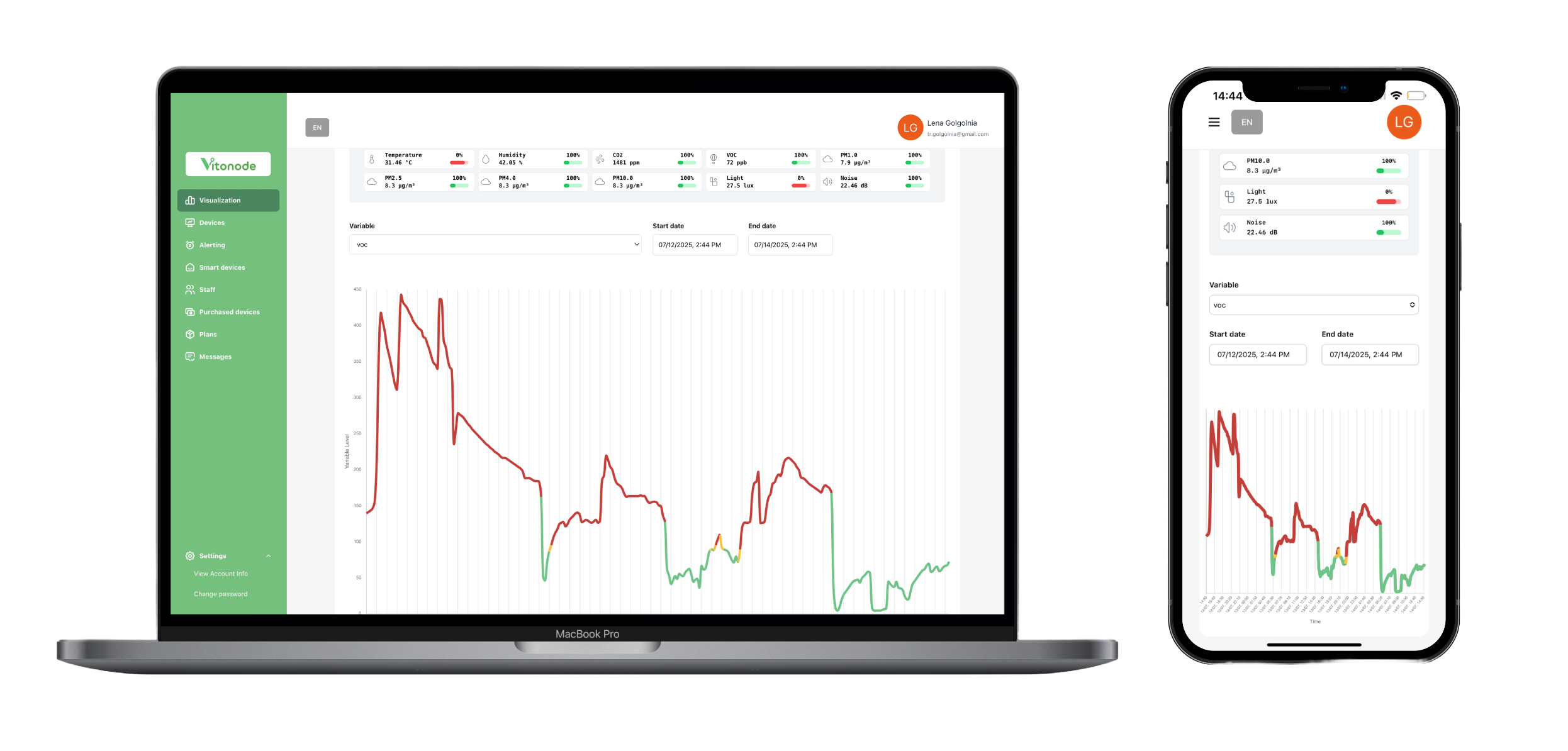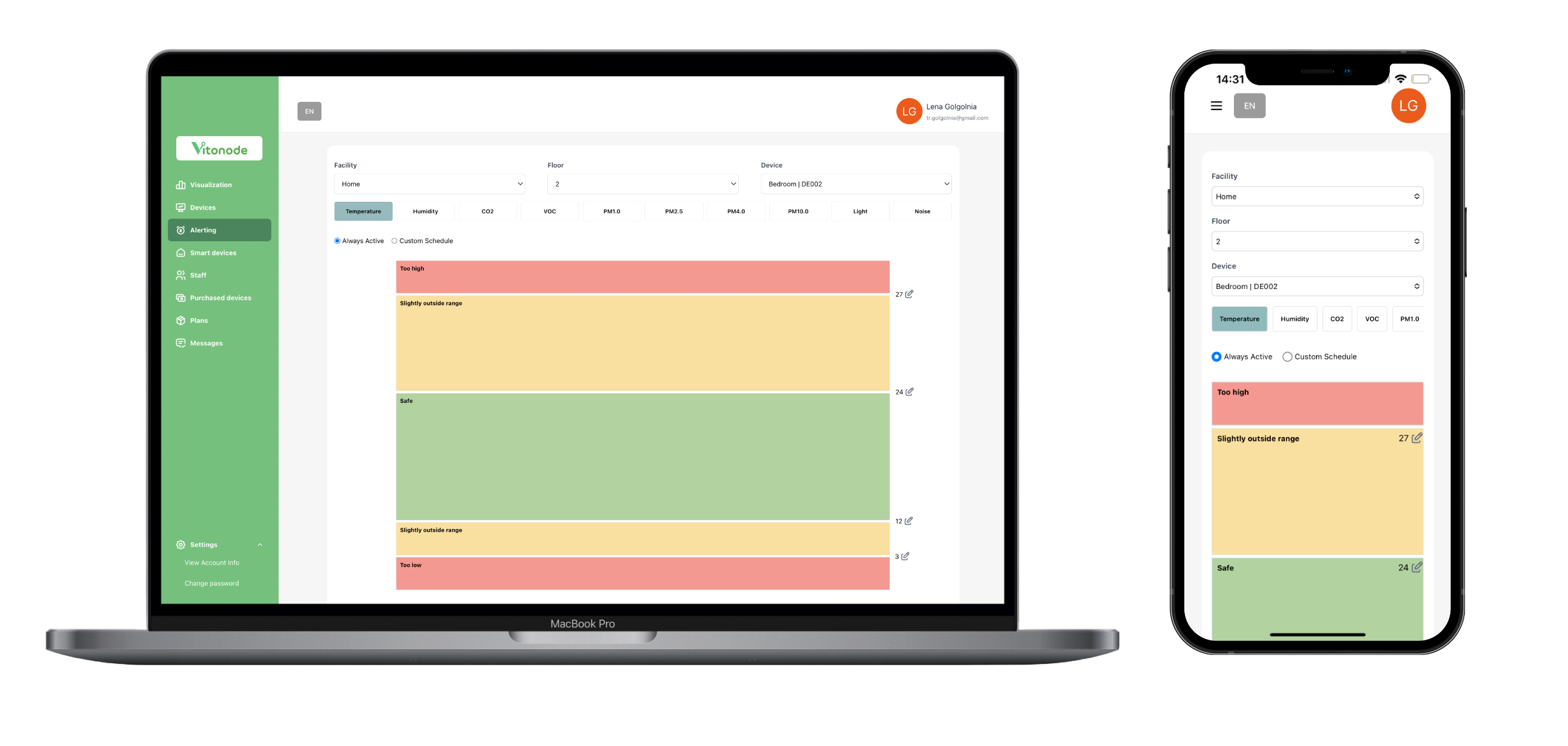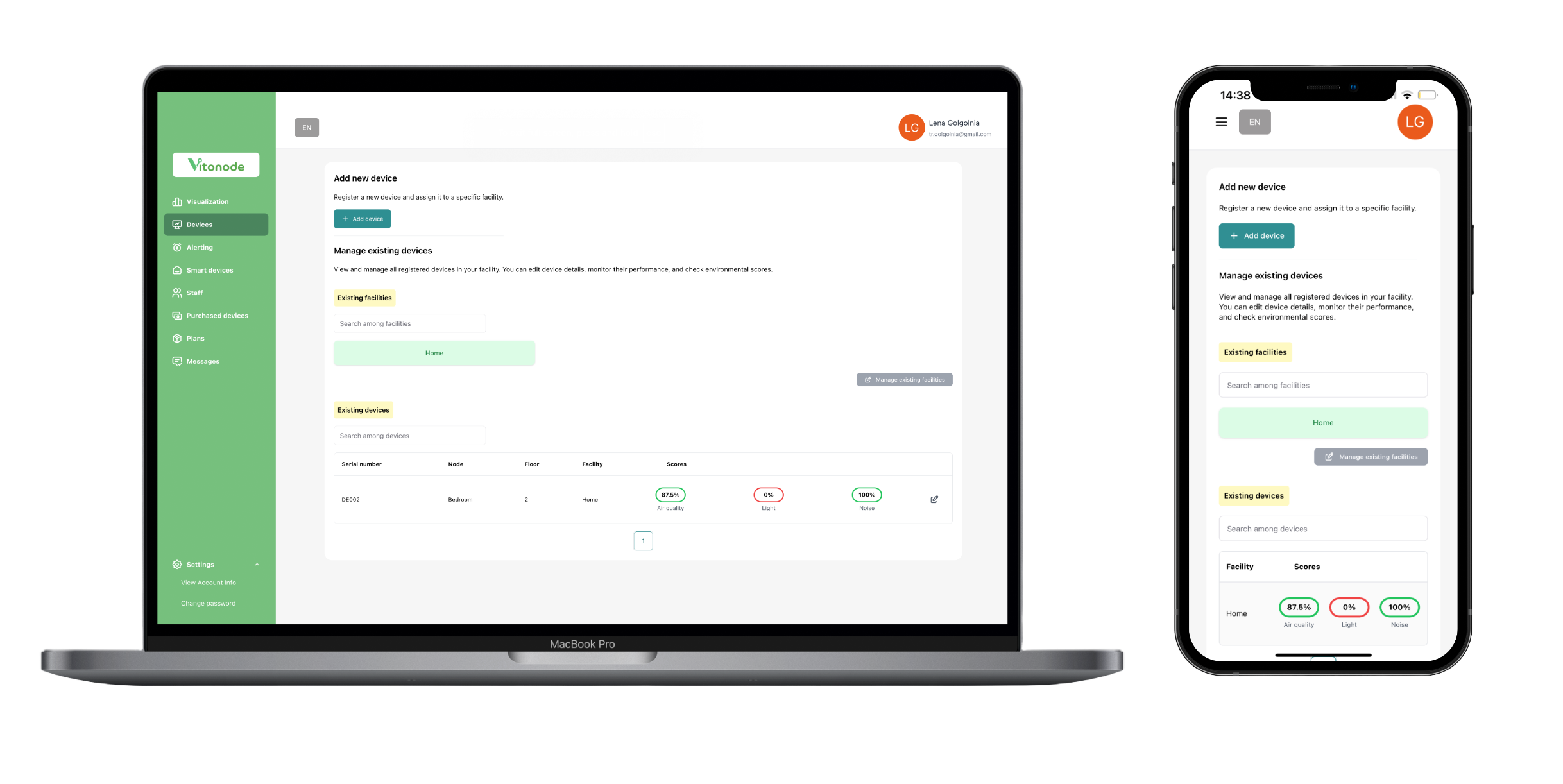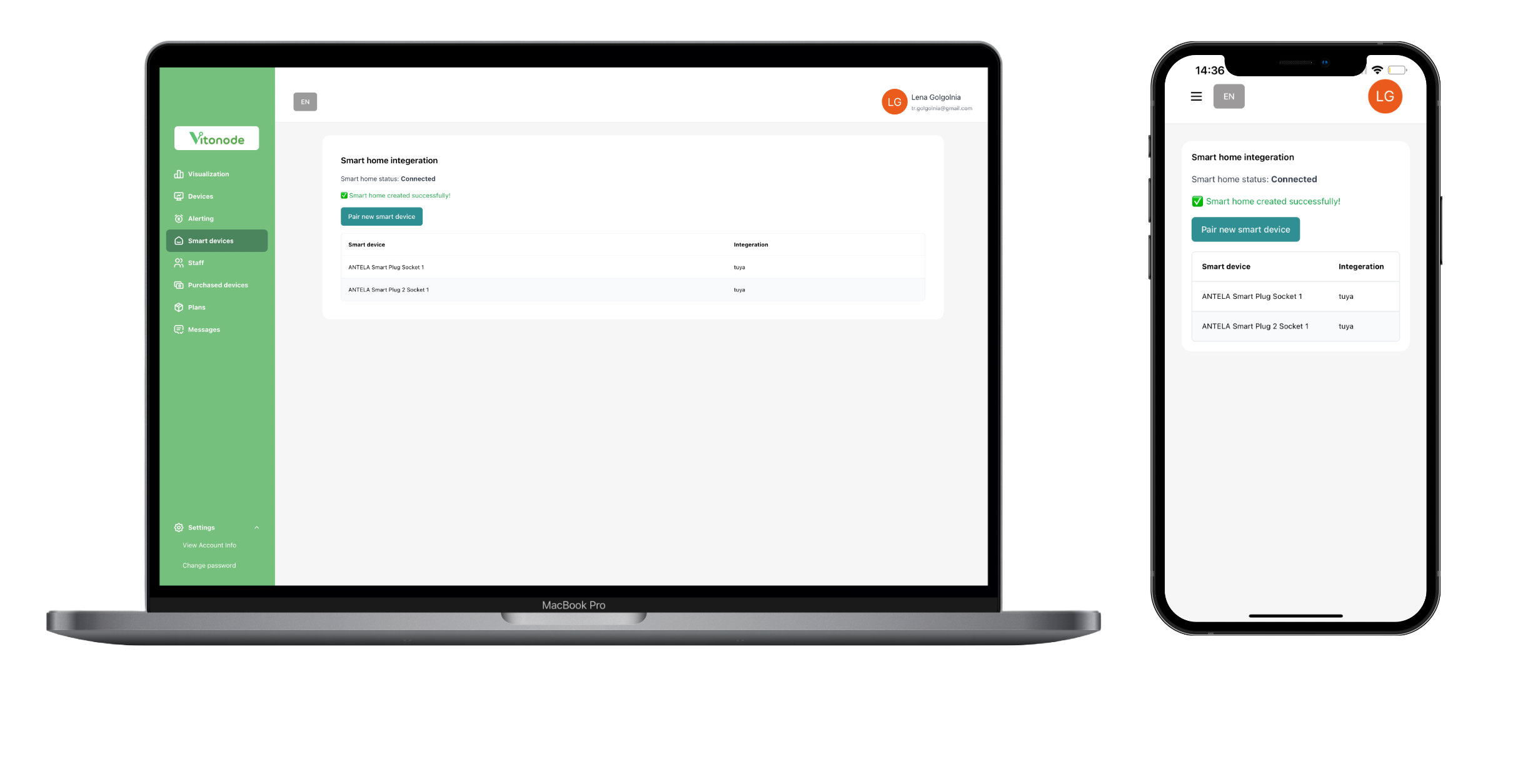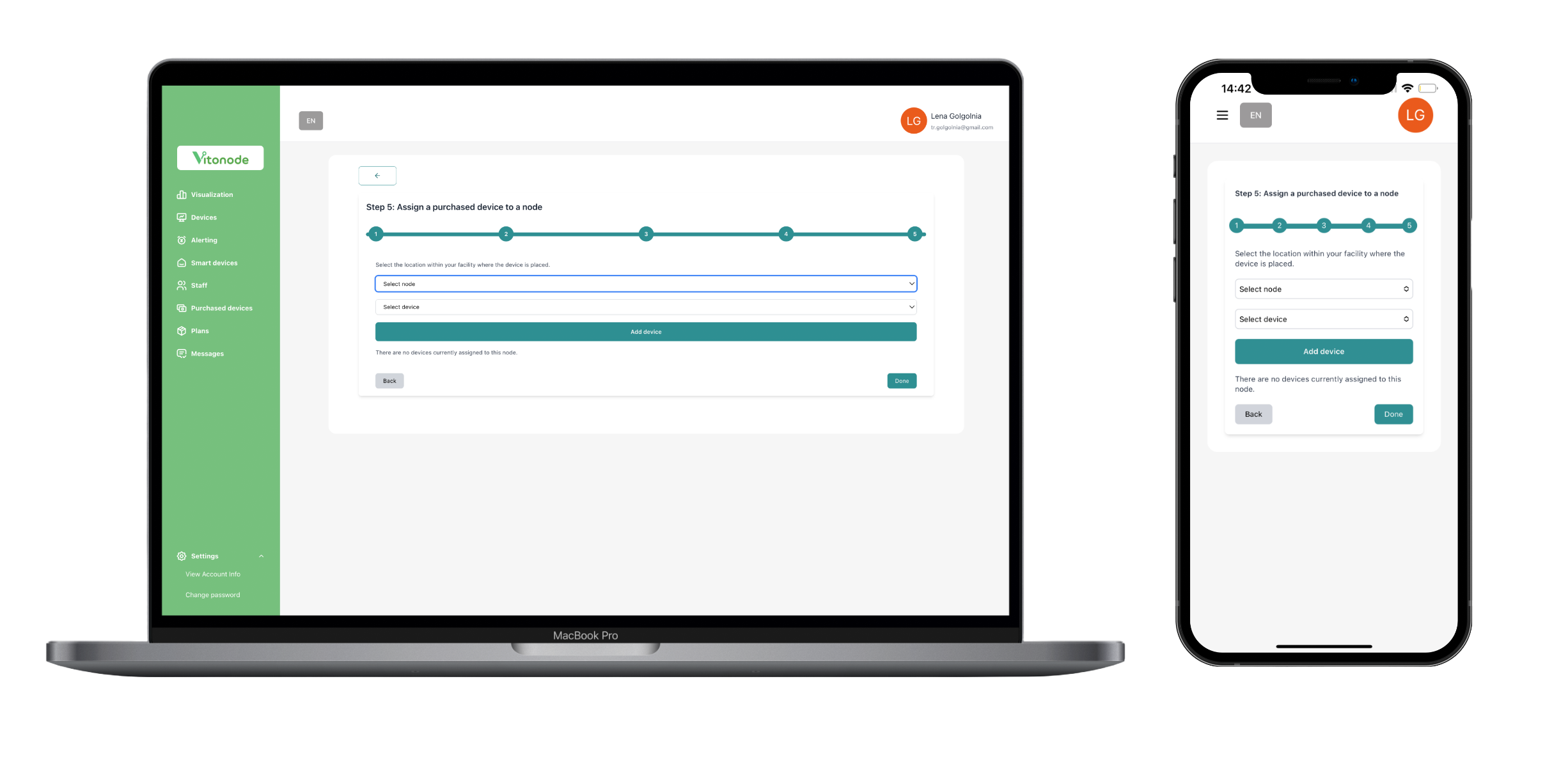We are establishing healthier indoor environments in healthcare facilities at a whole new level – creating:
✔ noticeably healthier living conditions for residents,
✔ a strong market position with a clear focus on indoor environmental quality,
✔ improved and more effective fulfillment of responsibilities for caregivers and staff,
✔ health-oriented facility management that supports long-term well-being and operational excellence.
Fact & feeling at a glance
Two complementary solutions – health-oriented real-time control of dynamic environmental factors and architecturally grounded design of healthy spaces
To achieve exceptionally high indoor quality in healthcare environments that truly enhances the well-being of patients and staff, two complementary components are required:
On the one hand, health-focused optimization of dynamic environmental factors – such as smart climate devices, lighting systems, or air purifiers that automatically adjust to relevant health criteria. On the other hand, health-promoting architectural design, which provides a stable foundation for healthy indoor spaces through material choices, spatial structure, and construction elements.
This is exactly where our approach at Fact & Feeling comes in!
Fact & Feeling offers digital and intelligent solutions and products for healthcare settings – addressing both dynamic environmental factors and architectural design, to create healthy indoor spaces from the ground up:
Health-centered, smart, and real-time optimization of dynamic environmental factors like air quality, noise, and light – powered by our self-developed, integrated plug-and-play IoT system, which requires no additional infrastructure and is ready for use in seconds – fully automated.
Rule-based analysis, algorithmic evaluation, and targeted improvement of architectural design – from material selection to spatial layout: robust, data-driven, and user-oriented, based on our computational evaluation model for analyzing hundreds of architectural influence factors.
Core of our solution: data-driven intelligence with innovative logic for healthy spaces
With our data-driven solutions – smart IoT-based indoor monitoring and control, combined with algorithmic architectural analysis – we create high-quality, health-promoting indoor environments with a noticeably improved quality in the healthcare sector.
➊ Health-centered indoor optimization through an intelligent, end-to-end IoT solution
Plug & play: fully automatic – measurement, analysis, optimization
Air quality (temperature, humidity, CO₂, VOCs, particulate matter), acoustics, and light influence everyday experiences in healthcare facilities – for patients as well as staff.
Our IoT system combines advanced sensors with intelligent software:
🔸 Real-time measurement
🔸 Visualization of key values
🔸 Alerts when thresholds are exceeded
🔸 Health-based evaluation of all factors
🔸 Automated control of smart devices and building systems
The entire process chain – from data acquisition to user-specific recommendations or automated control – is integrated and immediately operational. This not only makes indoor conditions more transparent, but also actively supports health while conserving resources.
➋ Health-effective architecture – precisely analyzed, specifically improved
With our computational evaluation model
Architectural design – including zoning, furniture, material selection, or color schemes – significantly influences health outcomes and well-being in healthcare environments.
Our data-based analysis model evaluates over 400 influence factors based on scientific findings and practical experience. The goal is a well-founded and objective assessment of your interior design:
🔸 Status assessment and gap analysis of your facility
🔸 Comparison with best-practice models
🔸 Categorized, prioritized action recommendations
As needed, we translate results into concrete design suggestions, including realistic 3D visualizations for clear presentation. Naturally, we support you throughout – from planning to implementation and construction monitoring.
Product features and characteristics for optimizing environmental factors
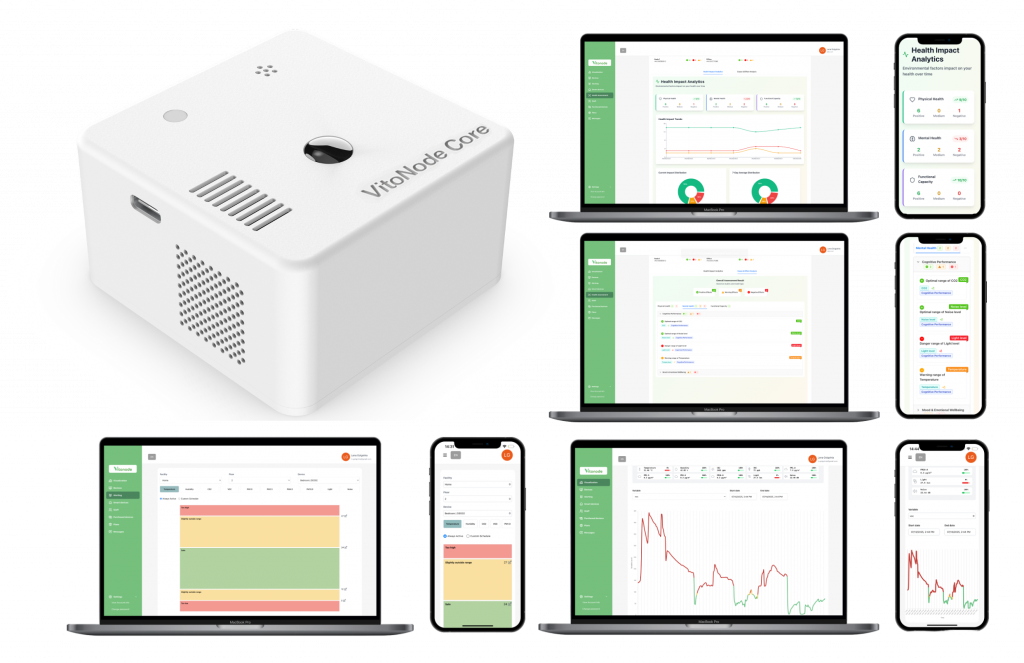
The integrated hardware-software system is designed and developed to contribute to the creation of healthy indoor environments while also reducing the workload of caregiving and technical staff by operating reliably and independently in the background without requiring additional technical effort. Well-thought-out automatic and smart functions enable stable operation with high everyday usability and minimal need for supervision.
All-in-one hardware and software solution – specially designed for healthcare settings
The integrated system combines sensor hardware with a custom-built software platform. The system operates as a fully integrated solution, without the need for additional devices or software installations. For you, this means: easy handling, reduced technical effort, and minimal maintenance – ideal for facilities with limited resources or no in-house IT staff.
Wireless real-time data transmission for improved environmental monitoring
All measurement data – such as temperature, air quality, humidity, or noise – is transmitted wirelessly and in real time. This allows you to place sensors flexibly in any room of the facility – without the need for wiring or structural modifications. This flexibility is especially beneficial in sensitive areas such as resident rooms, therapy spaces, or common areas. Continuous real-time monitoring helps care staff respond more quickly to changes – before the indoor environment negatively impacts well-being.
Easy deployment – flexibly expandable as needed
No structural modifications required – The device simply needs to be powered and immediately begins collecting data.
Effortless scalability – Whether you want to monitor a single room or an entire building, the integrated system grows with your needs.
Multiple nodes (devices) per floor or unit – All data is consolidated on a single platform and can be accessed remotely – ideal for management staff and external quality assessments.
Continuous automatic analysis of environmental factors with a focus on health and well-being
Environmental factors are not only recorded but are continuously analyzed algorithmically with a focus on their potential health impact. Insights into physical and mental health, as well as performance capacity, are systematically incorporated into the evaluation. This creates a solid foundation for targeted optimization of environmental conditions and the sustainable promotion of well-being.
Threshold values & automatic alerts
Define individual threshold values for environmental factors. If a value is exceeded – for example, high CO₂ levels or excessive noise – you receive an automatic notification. This allows care staff or facility management to intervene early, before discomfort arises or health risks escalate.
Intuitive, self-explanatory software
The user interface is designed to be suitable for both technical and non-technical users. Care staff, management, or external specialists can easily view, compare, and use the environmental data as a basis for decision-making – without the need for training. All functions are visually structured and intuitive – making them easy to understand even for larger teams or rotating users.
Custom access rights for team members and partners
Define who can view or manage which data. For example, you can grant a ward manager access to their own units, while central administration or external auditors receive only selected reports – fully GDPR-compliant and secure.
Integration with smart devices and automated control in your facility
The system can be connected to various smart devices in the facility, such as air purifiers, heating, ventilation, or lighting systems. If a previously defined threshold is exceeded – for example, due to poor air quality, increased temperature, or excessive noise – an appropriate response is triggered automatically. This ensures not only continuous monitoring of environmental conditions but also targeted, automated control – without manual intervention by staff. It creates stable, health-promoting indoor conditions while reducing the daily workload for care staff and facility management.
Control intelligence for healthcare facilities: Context-based & priority-driven
Our IoT control logic makes healthcare environments intelligently adaptable: it automatically resolves conflicts between environmental factors (such as CO₂, temperature, or noise), prioritizes actions based on room context and health goals – enabling real-time, health-optimized decisions. Fully configurable for every area of your facility, from care spaces to administrative offices.
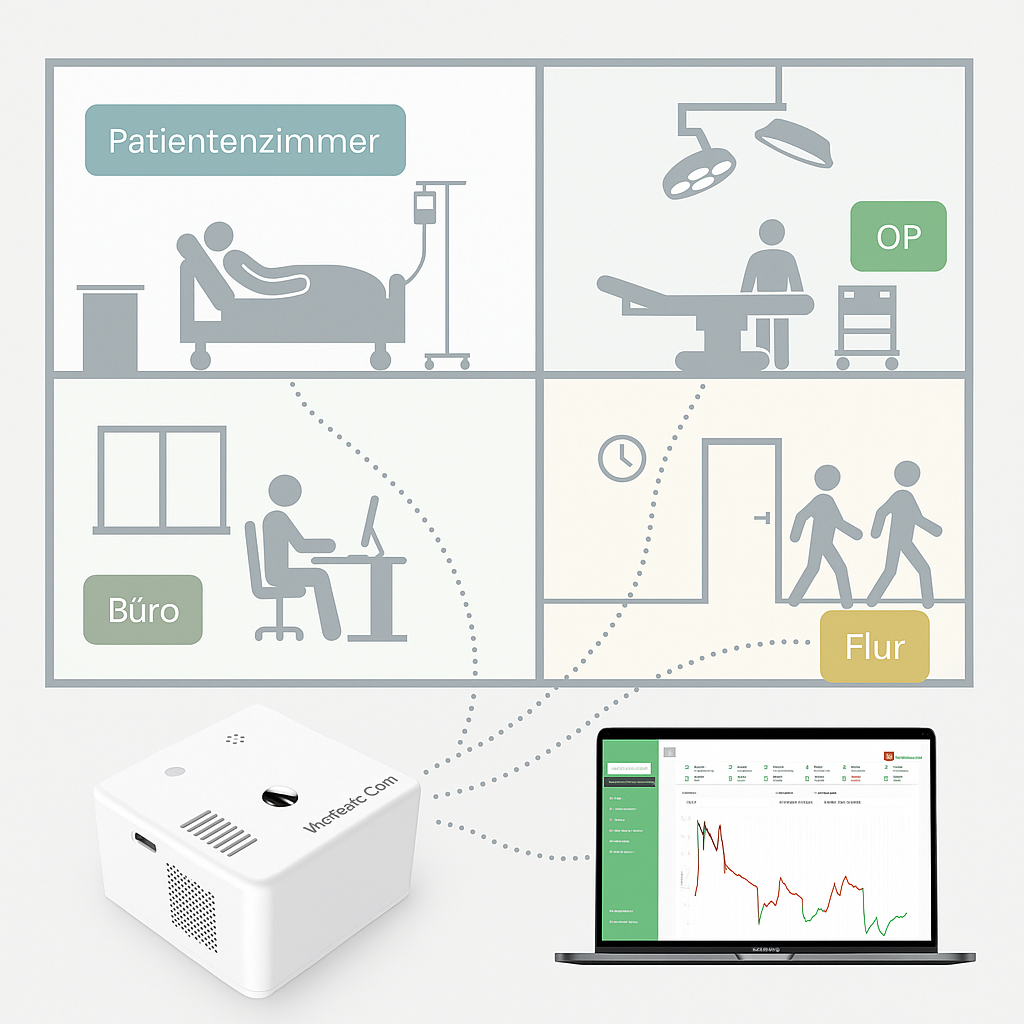
Demo view of the platform from measurement to real-time optimization of environmental factors
With the software, you always have control over the indoor environment in your facility, based on the continuously transmitted data from the device. Whether different locations, floors, or specific areas such as multipurpose rooms, activity spaces, dining halls, care stations, or resident rooms: the software presents the data in a structured way and enhances it with automatic and smart analysis functions – including evaluation, alerting, and optimization features with improvement recommendations, and even the option to control connected smart devices.
Targeted support for your care staff and facility managers
In healthcare facilities, different stakeholders are responsible for the well-being of residents and patients. Fact & Feeling provides targeted support to help them fulfill this responsibility more efficiently, effectively, and in a context-sensitive way. Two key areas of responsibility – care staff & personnel and facility management & technology – receive tailored guidance for their specific tasks.
Your care staff can use the app or web platform to get a real-time overview of the health-relevant conditions in each room. Alerts and notifications – tailored to room type and use – help them respond early, without additional effort.
Your facility managers also benefit: health-related criteria can be seamlessly integrated into existing systems. Through interfaces like API, MQTT, or CSV, data is automatically transmitted, analyzed, and made available – for proactive and efficient action.
High adaptability to your optimization strategy and infrastructure
Fact & Feeling offers numerous features for flexible alignment with your optimization strategy and existing infrastructure – delivering tailored functionality with real value.
Whether you only need recommendations for manual action, a fully automated control system, or even a combination of both – Fact & Feeling supports your strategy. Both options can be precisely adapted to the processes and requirements of your facility.
Every facility has a different technical setup. Whether your devices are based on traditional systems, smart plugs, or gateways – Fact & Feeling provides numerous integration options. The system adapts to your infrastructure, is modular in design, and remains compatible in the long term.
Purchase the sensor device for accurate monitoring of environmental factors
Our IoT devices for monitoring environmental factors are available in two versions:
✔ Version 1: With ten sensors – for air quality, light conditions, and noise levels
✔ Version 2: With eight sensors – for comprehensive air quality measurement
Both versions offer the same powerful software features for real-time analysis, environmental assessment, and intelligent optimization – regardless of the chosen sensor configuration.

- Temperature
- Humidity
- VOC
- CO₂
- PM₁, PM₂.₅, PM₄, PM₁₀
- Light Intensity (Lux)
- Noise Level (dB)
Software subscription for environmental factors
The software subscription from Fact & Feeling is designed to flexibly adapt to the requirements of nursing homes, clinics, and other healthcare facilities – while offering a particularly cost-efficient solution for your facility.
Two feature packages
Number of devices and users
Pricing benefits for multiple areas
Pro Plan
Pricing & Scaling
🔸 Starting at 9 €/month for 1 device and 1 user
🔸 Scalable to any number of devices and users
🔸 Volume discounts as demand grows
Features
✔ Data visualization
✔ Alerts when thresholds are exceeded
✔ User-based improvement suggestions
➕
✔ Automated control of smart devices and building systems
Steps for purchasing and commissioning the product for environmental optimization
Commissioning the product is quick and easy: After selecting and ordering the appropriate device variant, the setup takes just a few steps: place the device, activate the software – and automatic data collection begins immediately. Through the intuitive interface, users gain instant insights and analysis, can adjust alerts, and receive targeted notifications. Optimization takes place either automatically via connected devices integrated with the product or manually based on the product’s recommendations.
Depending on the area of use — whether resident rooms, common rooms, therapy areas, or offices — different variants with adapted sensor combinations are available. All devices offer the same basic functionality, regardless of the sensor selection. Our team will support you in choosing the best fit for your facility.
Once the device is delivered, the corresponding software subscription is activated. This is based on the number of devices and users. Access rights for different roles — e.g. care staff, facility management, or supervisors — are assigned individually according to your organization’s structure.
Devices are placed exactly where relevant — e.g., in resident rooms to monitor air quality or in hallways near activity areas. An open space without direct influences like radiators or closed cabinets ensures precise measurements.
As soon as the device is activated, continuous data collection and secure measurement logging begin. Real-time data provides the current situation and long-term data enables pattern recognition — such as identifying persistent problem areas.
All data is accessible through an intuitive user interface — whether for trend analysis or health reporting. Even non-technical staff can quickly access information. Professionals gain insight into critical conditions and can detect risks or optimization opportunities immediately.
If, for example, CO₂ levels or noise exceed defined limits in a resident room, automatic alerts are triggered. Thresholds are freely configurable and can be adapted to the needs of each area — whether for dementia wards, therapy spaces, or administrative offices.
Based on the analysis, environmental factors can be specifically optimized – the product enables both automated control and manual interventions, depending on your preference. Automated control is achieved by connecting devices such as air purifiers, window actuators, or lighting systems to the product. This product offers various integration options for this. Alternatively, staff members in your facility can respond manually – guided by clear action recommendations provided by the product.
How optimized environmental factors support health and well-being
Environmental factors influence the quality of life for residents and staff in many ways — often with great impact. Fact and Feeling makes these relationships visible and enables targeted measurement, analysis, and optimization of environmental conditions for a healthy and supportive setting.
How the facility itself benefits from healthy environmental factors – beyond the residents
In healthcare facilities, the well-being of patients, residents, and staff takes top priority. At the same time, efficient and sustainable building operations are essential. Targeted optimization of environmental factors supports both: it improves health conditions while reducing energy and maintenance costs – without placing additional burdens on staff.
Save energy through intelligent control
Heating, ventilation, air conditioning, and lighting are automatically adjusted to the actual room conditions. This reduces energy consumption noticeably – without compromising comfort for residents or staff. Especially in facilities with continuous operation, this results in high savings potential.
Ensure compliance with standards – with proof
Healthcare facilities are subject to strict requirements regarding room climate, air quality, and noise protection. The automatic documentation of environmental values supports compliance with legal regulations, hygiene standards, and quality guidelines – making audits and certifications in the health sector easier.
Preventive maintenance through early detection
Humidity, poor air quality, or critical temperature ranges can be detected early – before they cause structural damage or health risks. This helps prevent mold, excessive CO₂ levels, or unknown problem sources, and allows building systems to be maintained more efficiently.
Automated processes relieve the staff
By connecting to smart devices and systems (e.g., ventilation, air purifiers, or lighting control), adjustments are made automatically – without manual intervention by care or facility staff. This frees up time for what truly matters: caring for people.
Reliable support – always there for you
With our system, you not only receive a reliable solution for health and environmental monitoring, but also a support team that understands the everyday operations in your facility – and acts accordingly.
◾️ Available – even on weekends
◾️ Quick response and personal support
◾️ Easy access – via ticket or direct call
Quality you can rely on – with 2-year warranty
At Fact and Feeling, we prioritize high product quality and flawless functionality at every level. If your product shows any material or manufacturing defect within two years, we will provide a fast and hassle-free solution – whether that means repair, replacement, or a refund. Simply contact us at: contact@factandfeeling.com
Rethinking architecture and design for health – with the data-driven solution from Fact & Feeling
In addition to the dynamic optimization of environmental factors, Fact & Feeling also offers a data-driven solution for evaluating and specifically improving architecture and design.
Health-promoting architecture and design support the well-being and health of people in healthcare facilities in many ways. Thoughtful design can simplify everyday routines, promote independence, and create an atmosphere that fosters community, safety, inclusion, and recovery.
Fact & Feeling has developed a data-driven software tool with a calculation model for assessing architecture and design in healthcare settings. It is based on hundreds of scientific publications and industry insights. The tool analyzes healthcare environments using architectural variables and their direct and indirect impact on physical, psychological, and behavioral health indicators.
Instead of assuming what might work, the software clearly shows which aspects of your facility promote health – and where there is still room for improvement. Whether it’s about reducing stress and anxiety, enhancing orientation and autonomy, or strengthening social interaction, the software reveals what elements are supportive – and which ones may unintentionally hinder well-being.
In this way, design becomes a strategic tool – one that strengthens residents and staff not only visually, but also functionally and emotionally. Every single day!
What is the logic and methodology behind the evaluation of architecture and design?
At the heart of the software developed by Fact & Feeling for evaluating architecture and design is a computational model that serves as the core calculation engine. This model is based on mathematical algorithms that analyze over 400 interactions between architectural variables and health- or well-being-related criteria.
Data basis
The input data consists of the specifications of the facility, captured as architectural variables – gathered through:
◉ On-site assessments,
◉ Architectural drawings,
◉ Configuration data,
◉ Materials and
◉ Furnishings.
Analysis and results
Once the data is entered, the software automatically processes it and generates results. In addition to the results provided by the software, a detailed interpretation is also included.
What does the evaluation and optimization of architecture and design involve?
The evaluation of architecture and design is based on a systematic analysis of architectural variables and their impact on health-related criteria. The assessment is carried out using a computational model within our specially developed software, which delivers both quantitative and qualitative results along with prioritized recommendations – clearly visualized for ease of understanding. This is complemented by comparisons with best-practice models, individually tailored architectural planning, and continuous scientific development – for an evidence-based, practical improvement of spaces in healthcare environments.
Comprehensive variables and criteria
The software takes into account a wide range of categories of architectural variables — from spatial configuration to materials and colors, as well as furnishings and the ambient environment. These variables are analyzed in terms of their impact on various health criteria, including both physical and psychological aspects. The impacts are defined and modeled as nearly 450 interactions between the architectural variables and the health-related criteria.
Automated and precise analysis
The software uses mathematical algorithms to analyze architectural data automatically and precisely. This saves time, minimizes potential sources of error, and enables consistent analysis of numerous factors. The software delivers reliable results that support well-informed decision-making.
Quantitative evaluation
Each architectural variable is quantitatively assessed based on how positively or negatively it impacts health. The aggregated results highlight which areas are particularly beneficial or in need of improvement.
Qualitative and root cause analysis
In addition to quantitative assessment, the software provides in-depth qualitative insights. It analyzes how specific architectural variables – such as spatial design – directly influence residents’ well-being and identifies the underlying causes of certain effects.
Categorized and prioritized recommendations
The collected data is transmitted in real time to a database and visualized in a user-friendly software interface. Environmental factors are displayed in the form of charts and statistics. At the same time, analysis tools make it possible to identify trends and evaluate anomalies, ensuring comprehensive monitoring and assessment of the data.
Comparison with best-practice models
The analysis includes a comparison with established best-practice models to show the facility’s position within the healthcare sector. This provides valuable benchmarks for optimization and strengthens overall competitiveness.
Architectural planning for improvement
The results of the evaluations and gap analyses serve as a foundation for improvement within the healthcare facility. Based on the facility’s priorities and needs, Fact and Feeling then develops customized architectural planning. Fact and Feeling supports the healthcare facility through all project phases – from preliminary analysis and design planning to execution planning and implementation supervision. This ensures that the entire process – from evaluation and gap analysis to architectural planning and successful implementation – is seamlessly integrated and perfectly aligned with the facility’s objectives.
Continuous scientific and practice-oriented updates
The software is continuously updated with the latest scientific findings and industry best practices to keep the logic and interactions between architectural variables and health criteria up to date. By integrating current research and proven methods, it ensures a sound and contemporary analysis of architectural variables. This enables data-driven decision-making aligned with the latest developments in healthcare architecture and care facilities, consistently providing optimal, evidence-based recommendations for design and planning.
Demo view of the software for evaluating architecture and design
Discover how your environment impacts patients and staff – and how you can improve it in a targeted way. Our software makes the effects of architectural design on health, well-being, and functionality visible – scientifically grounded and practically prepared.
Steps from evaluation to optimization of architecture and design
The path to a ready-to-use system is simple and tailored to the daily routines in healthcare facilities – from selection to active use with automated support for care, therapy, and facility management.
During an on-site visit, relevant information is gathered, including spatial conditions, materials, furnishings, and equipment. Existing architectural drawings and planning documents are reviewed. In discussions with stakeholders, needs, problems, and requirements are recorded. All entries are structured and entered into the software — especially room configurations, material qualities, and functional assignments.
The software generates reports containing quantitative metrics, qualitative assessments, and a root-cause analysis. Specific room types, such as patient rooms or communal areas, are analyzed in detail. The results are compared with recognized best-practice models to highlight potential areas for improvement.
Identified areas for improvement are prioritized and translated into concrete recommendations for action. These recommendations are categorized by topic and aligned with the defined goals. A sensitivity analysis helps assess the effectiveness of individual measures.
The architectural planning is based on the evaluated results, defined priorities, and functional requirements. A customized planning concept is developed, which can cover all service phases up to construction supervision.
Service package for evaluating and optimizing architecture and design
Since the needs of healthcare facilities vary, we offer four packages for architectural analysis and optimization. This allows you to choose the right package based on your project goals and the desired planning scope. The packages range from a basic assessment to 3D visualization and expert support during implementation.
Package 4: Pre-premium evaluation + 3D visualization + implementation support
- Initial status assessment
- Root cause analysis
- Gap analysis
- Tailored improvement strategies
- Sensitivity analysis of architectural variables
- 3D visualization of the recommendations (practical representation of optimization proposals)
- Proactive implementation support (technical guidance during implementation)
We support architecture firms and healthcare institutions as partners – to jointly develop healthier spaces
Are you an architecture firm or an institution in the field of healthcare buildings – and looking to make your planning processes more systematic, impact-oriented, and data-driven?
Fact & Feeling supports you with tailored digital evaluation models, architecture-specific computational tools, and scientifically grounded decision-making frameworks – for a collaborative partnership on equal footing.

